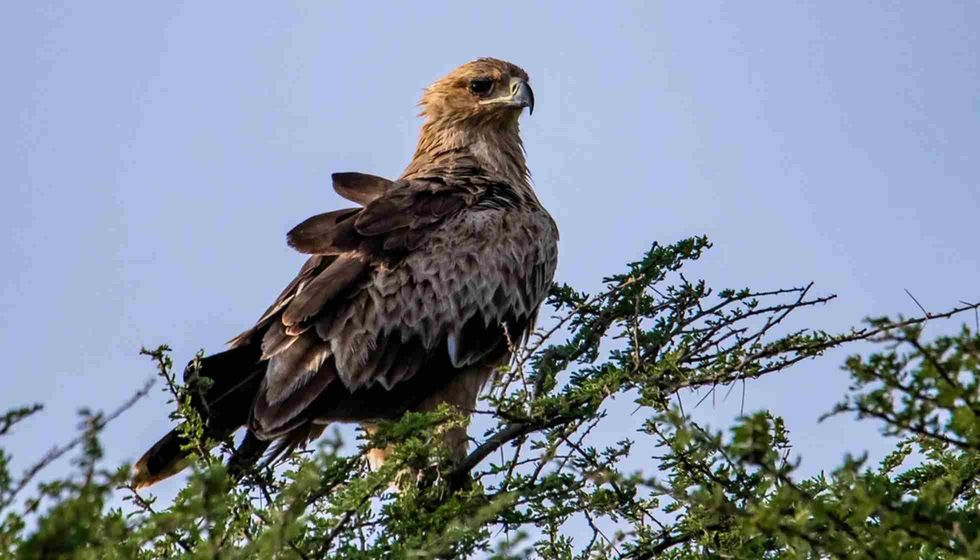Amongst one of the most impressive hunters of Africa, the crowned eagles are beautiful, agile, and formidable, winged predators. The majestic bird of prey is known as the crowned eagle and is referred to as Stephanoaetus coronatus crowned eagle in various scientific articles and research blogs.
Their brilliance of hunting leads them to prey on organisms even several times more than their own body weight, making it the most powerful eagle species.
Found in the forests, mountains, and grasslands of southeastern and central Africa, this bird is the fifth-longest extant eagle in the world, estimated to be between 31-39in long.
Similar to other predatory birds the female is larger than their male counterparts by almost 10-15 percent. A crowned eagle is considered Africa's most powerful eagle species and an adult crowned eagle can weigh up to 4.7 kg.
These birds are named ‘crowned eagles’ due to the presence of the specific russet-brown crowns on the head. Read on to learn about the crowned eagle (Stephanoaetus coronatus).
After going through these interesting facts about crowned eagles, check out our articles on the eagle and tawny eagle too.
Crowned Eagle Interesting Facts
What type of animal is a crowned eagle?
The crowned eagle, also known as the African crowned eagle, is an organism belonging to class Aves; that is birds. The crowned eagle is basically a large prey bird found in parts of Africa, primarily in South Africa and central Africa. African crowned eagle is believed to have been evolved from Malagasy crowned eagle.
What class of animal does a crowned eagle belong to?
The crowned eagles belong to class Aves, of subphylum Vertebrata.
How many crowned eagles are there in the world?
According to the present estimates, the number of African crowned eagles is placed at about 10,000 birds. Crowned hawk-eagle (Stephanoaetus coronatus) is regarded as an endangered species and efforts for its conservation are being organized in Africa.
Where does a crowned eagle live?
The crowned eagles live in a nest where, after breeding, they also lay the eggs. Adult crowned eagles are found in various parts of Africa, such as certain areas of sub-Saharan, parts of central Ethiopia and Uganda in East Africa, forested parts of Kenya and Tanzania. However, their population has become quite low in areas of West Africa.
What is a crowned eagle's habitat?
The preferred habitat of the crowned eagle is a nest. The nest of a crowned eagle can be present in dense woodlands, hilly areas, and mountainous regions covered with thick forests.
Who do crowned eagles live with?
The crowned eagles are found to live in solitary as well as in pairs. However, their habitat is rarely found amongst the human population due to the powerful hunting instincts of the crowned eagle. There have been some reports wherein crowned eagles considered human toddlers as their prey.
How long does a crowned eagle live?
The average lifespan of a crowned eagle is about 14-15 years.
How do they reproduce?
The crowned eagles are monogamists; that is, organisms that choose only one partner for the process of breeding. Since these predatory birds have one of the longest breeding cycles, (up to 500 days) they tend to breed only every two years.
The mating process starts when the male performs an undulating display flight followed by loud vocalization.
Following the mating, the female crowned eagle lays about one or two eggs in the nest. She incubates the eggs in the nest for 49-51 days, while the male crowned eagle provides food.
The chick hatches and develops its first feathers at about 40 days. In the case of two chicks, the theory of “the survival of the fittest" sets in, as the stronger juvenile crowned eagle kills the weaker soon after hatching in the nest.
The surviving progeny is carried for the next 40 days by its mother and after, fledging for 115 days (the process of developing wing feathers that are large enough for flight) takes place.
The young (medium-sized) crowned eagle experiences its first flight after 115 days. The post-fledging period extends up to 11 months.
What is their conservation status?
According to the IUCN Red List, the crowned eagle are categorized under the Nearly Threatened species category. Hence, it is feared that this species might face extinction in the near future.
Crowned Eagle Fun Facts
What do crowned eagles look like?
The crowned eagle is an extremely large eagle species. They possess thick and strong legs.
They have long talons on each of the back toes, which contains an impressive set of weapons for predation. Thus they are able to kill animals more than seven times the crowned eagle size.
The crowned eagle wingspan ranges between 5-5.9 ft. However, the lack of wing length is overshadowed by the width, as they have broad rounded wings.
This wing gives the crowned eagle an increase in maneuverability, which aids in the flight in a dense forest while on a hunt. The upper-parts of crowned eagles have an array of brown, black, and gray colors.
The tail, generally 30-41 cm long, has a mix of black and brown colors. With a combination of dark coloring, double crest, and large legs and talons, the African crowned eagle have the look of a menacing raptor who is ferocious while hunting.

We've been unable to source an image of a crowned eagles and have used an image of its habitat. If you are able to provide us with a royalty-free image of a crowned eagles, we would be happy to credit you. Please contact us at hello@kidadl.com.
How cute are they?
The crowned eagles are among the most formidable and ferocious birds of prey in the world, though they are beautiful and majestic to look at, they definitely are not cute animals. While flying, their underwing coverts are of chestnut color whereas the remaining underwing is white with considerable black markings.
How do they communicate?
The crowned eagles communicate through their loud calling voices. They are popularly known to possess loud cry voices while on the hunt.
How big is a crowned eagle?
With an average measurement of about 31-39 in (80-99cm) in length, the crowned eagles rate among the fifth-longest extant eagles in the world. African crowned eagle talons are so strong that in one swoop, the bird can crush the spine of any animal up to seven times its weight.
How fast can a crowned eagle fly?
The crowned eagle flies at a speed of 100 mph while hunting, which is amongst the fastest in eagles.
How much does a crowned eagle weigh?
The female crowned eagle weighs about 7-10 lb while the males crowned eagle weigh 6-9 lb. The females are about 10–15 percent larger than the males.
What are their male and female names of the species?
As the crowned eagle is a bird belonging to the species of Stephanoaetus coronatus, a male crowned eagles is referred to as male crowned eagle while females are referred to as female crowned eagle.
What would you call a baby crowned eagle?
The progeny of crowned eagles are referred to as a juvenile crowned eagle. They hatch from the eggs in the nest in around 51 days. The female crowned eagle completes a breeding cycle in almost two years which is almost three times that of the martial eagle (polemaetus bellicosus).
What do they eat?
The diet of a crowned eagle comprises meat only, as it consumes only a carnivorous diet. The white crowned eagle is known to feed on a number of forest animals such as monitor lizards, snakes, hares, squirrels, mongoose, feral cats, hyrax, and even small antelope.
The favorite area for completing a hunt is usually near their place of habitat in the forest.
Are they loud?
The crowned eagles are well known for their loud cry. Both the adult as well as baby crowned eagles usually have loud calling voices. They use their loud voices to scare off any encroachers from near their habitat.
Would they make a good pet?
Though the crowned eagle can be tamed at adolescence, they are known to possess a formidable temper. Hence the crowned eagles don't prove to be a good option as pets for families. If you are a trained handler, then it might be possible to keep the crowned eagle as a pet for hunting but is not recommended.
Did you know...
A crowned eagle can dive in the air at a speed of 100 mph (160 km/h). Crowned eagles rank amongst the most formidable and ferocious birds of prey in the world. The crowned eagles are rated as the fifth largest, ninth heaviest prey bird and are also listed amongst one of the 10 strongest present-day animals.
Many African tribesmen value the crown feathers of the crowned eagle as ornaments. The crowned eagle is the only surviving member of its genus.
Due to their unique wing shape, the flight of the African crowned eagle is remarkably stealthy and quiet. The favorite habitat for crowned eagles is a forest canopy.
In a zoo in San Diego, the first African crowned eagle in captivity was hatched in 1996.
Predatory habits
The crowned eagles rank amongst the apex predators of Africa. Besides hunting for animals such as monkeys, lizards, snakes, and mongoose for their diet; the crowned eagles have proved to be dangerous on the grounds of attacking human toddlers and livestock as well.
According to the reports of National Geographic, the crowned eagles have been reported to occasionally attack children residing near forest areas.
These birds can prey on organisms weighing up to 65 lb. Due to their peculiar predatory habits, they are often nicknamed “the leopard of the air”.
Why is the crowned eagle endangered?
The crowned eagles fall under the category of Nearly Threatened species and the main threat confronting these predatory birds is the loss of habitat. The factors such as intensive cattle ranching, forest clearance, or invasive grasslands are leading to the destruction of the natural habitat of these birds.
Here at Kidadl, we have carefully created lots of interesting family-friendly animal facts for everyone to discover! Learn more about some other birds including great green macaw, or fischer's lovebird.
You can even occupy yourself at home by drawing one on our Crowned eagle coloring pages.









